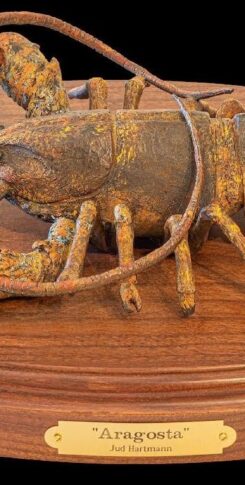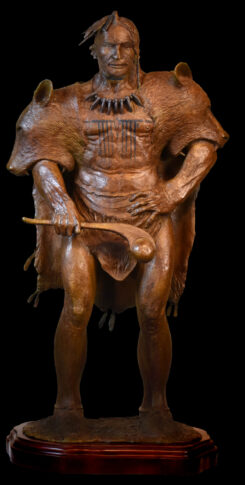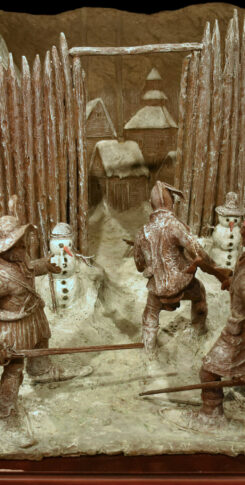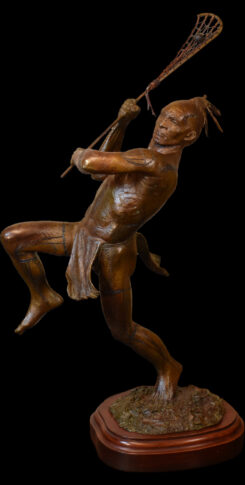2017 | Bronze edition: 35 | Width of base: 29″ | Height: 27″
The fur trade was the economic imperative, the life’s blood of New France. In the early 17TH c. the Huron were the primary trading partners of the French supplying about 10,000 beaver pelts annually. The majority of the pelts, (as well as those of moose, lynx, fox, otter, martin, badger and muskrat), were collected by the Huron from Algonkian tribes along the Ottawa River but especially from the North where furs exceeding both in quality and quantity could be obtained. The medium of exchange for the furs was primarily corn which the Huron grew in abundance as a commercial crop.
The symbiotic trade relationship between the agricultural Huron and the hunting people of the North was established long before European contact. The Huron incorporated the French and their exotic trade goods into that existing trade network. European contact in the early 17THc. between the Huron and the French (and similarly between the Iroquois and the Dutch) and the introduction of European trade goods stimulated a higher level of artistic expression among native people in: bone and wood carving, metal working, pipe and wampum manufacture and the working of textile fabrics. The result was a florescence of an already dynamic artistic tradition and in greater wealth generally.
A trip from the Huron Country to Quebec took about a month with up to 100 stretches of rough water necessitating laborious portages. The Huron approached the French trading stations by way of the Riviere des Praires to the north of Montreal island or through the Lachine rapids to the south. “Lachine” in French means “China”. These rapids derive their name, somewhat derisively, from the fact that this was the route believed by Jacques Cartier to be the Northwest Passage to the Orient. On his second voyage to the New World in 1535 Cartier penetrated the St. Lawrence as far as these rapids. Unable to get past them he mistakenly believed China lay Just beyond. Shooting the Lachine rapids required of the Huron canoe men great skill and daring, both of which qualities they possessed.
The Huron attributed much of the technological skill of the French to magic. Thus, the ability of the French would have seemed connected less to technological superiority than to luck in acquiring magical arts. The possession by the French of a particular kind of magic was no indication of their intrinsic cultural superiority. To the contrary, there is much evidence that the Huron looked upon the French as inferior, reflecting the high opinion the Huron had of themselves. They regarded the difficulties the French had in learning to speak Huron as evidence of their stupidity and thus explained all the difficulties the French had in acquiring skills the Huron held to be commonplace. The Huron also ridiculed beards as unnatural and disfiguring and feigned amazement that women would look favorably on a man who had one. They claimed beards were the cause of intellectual difficulties of the French. The Huron fancied themselves superior to the French, not only because they were taller and more robust physically but because they had no facial hair and therefore were more intelligent.






